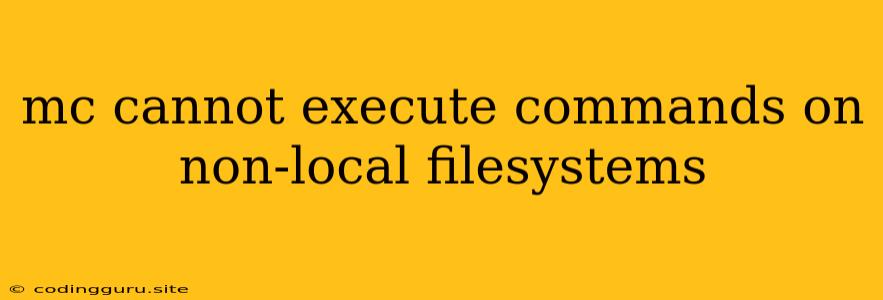"mc cannot execute commands on non-local filesystems" - A Common Error and its Solutions
This error message often pops up when using mc, a powerful command-line file manager, and it indicates that you are trying to perform actions on files located on a remote filesystem, which mc cannot directly execute. This usually happens when you are attempting to use mc to interact with files on network-mounted drives or cloud storage services.
Why is this happening?
mc is designed to work primarily with local filesystems. While it can be used to manage files on remote servers through the use of SSH, it doesn't have built-in functionality to execute commands directly on non-local filesystems.
How to troubleshoot and fix the error:
Let's break down some common scenarios and provide solutions for each.
Scenario 1: Accessing files on a remote server via SSH:
- Problem: You're attempting to access files on a remote server using
mcover SSH, and it's throwing the "mc cannot execute commands on non-local filesystems" error. - Solution: You can use
mcto manage files on a remote server by connecting through SSH. However, you'll need to usemcto manage the local files on the server and then utilize the server's command-line tools (likecp,mv,rm, etc.) for file manipulation.
Example:
- Connect to your server using SSH:
ssh username@server_ip - Use
mcto navigate the local files on the server. - Use the server's command-line tools to perform actions on the files.
Scenario 2: Accessing files on a network-mounted drive:
- Problem: You are trying to access files on a network-mounted drive using
mc, and you encounter the error message. - Solution:
mccan't directly execute commands on network-mounted drives. The best approach here is to use the operating system's built-in tools for managing files on the network drive.
Example:
- Mount the network drive using the appropriate command for your operating system (e.g.,
mounton Linux). - Use the operating system's tools (like
cp,mv,rm, etc.) to manage files on the mounted drive. - Once you're finished, unmount the drive to avoid unintended consequences.
Scenario 3: Accessing files on a cloud storage service (like Google Drive, Dropbox, etc.):
- Problem: You're trying to interact with files on a cloud storage service using
mc, and you get the "mc cannot execute commands on non-local filesystems" error. - Solution:
mcdoesn't have native support for interacting with cloud storage services. You'll need to use the cloud storage service's command-line interface, web client, or desktop application to manage your files.
Example:
- Install the command-line interface or desktop application for your chosen cloud storage service.
- Use the service's tools to access, manage, and manipulate your cloud files.
General Tips for Working with mc:
- Understand its capabilities:
mcis powerful, but it's primarily designed for local file system management. Be aware of its limitations when dealing with remote filesystems. - Use SSH for remote servers: When managing files on remote servers, utilize
mcto navigate local files and leverage the server's tools for file manipulation. - Leverage operating system tools: For network-mounted drives, rely on the operating system's built-in tools for managing files.
- Explore alternatives: Consider using dedicated cloud storage command-line interfaces or web clients for managing files on cloud services.
Conclusion:
The "mc cannot execute commands on non-local filesystems" error arises because mc is designed for local file system management. To manage files on remote servers, network drives, or cloud services, you need to employ alternative approaches utilizing SSH, operating system tools, or dedicated cloud storage applications. By understanding these limitations and employing appropriate strategies, you can overcome this error and effectively manage your files using mc.
